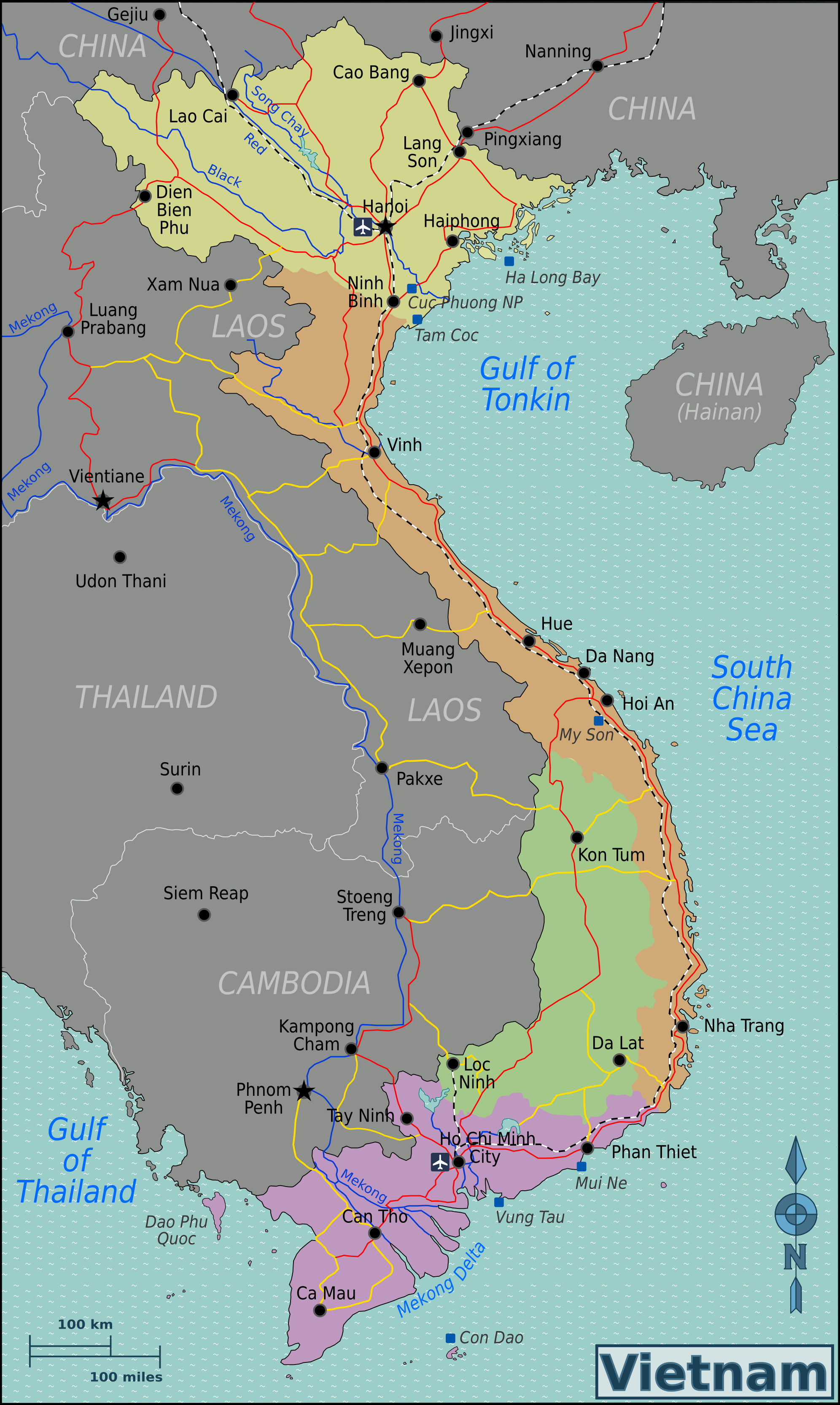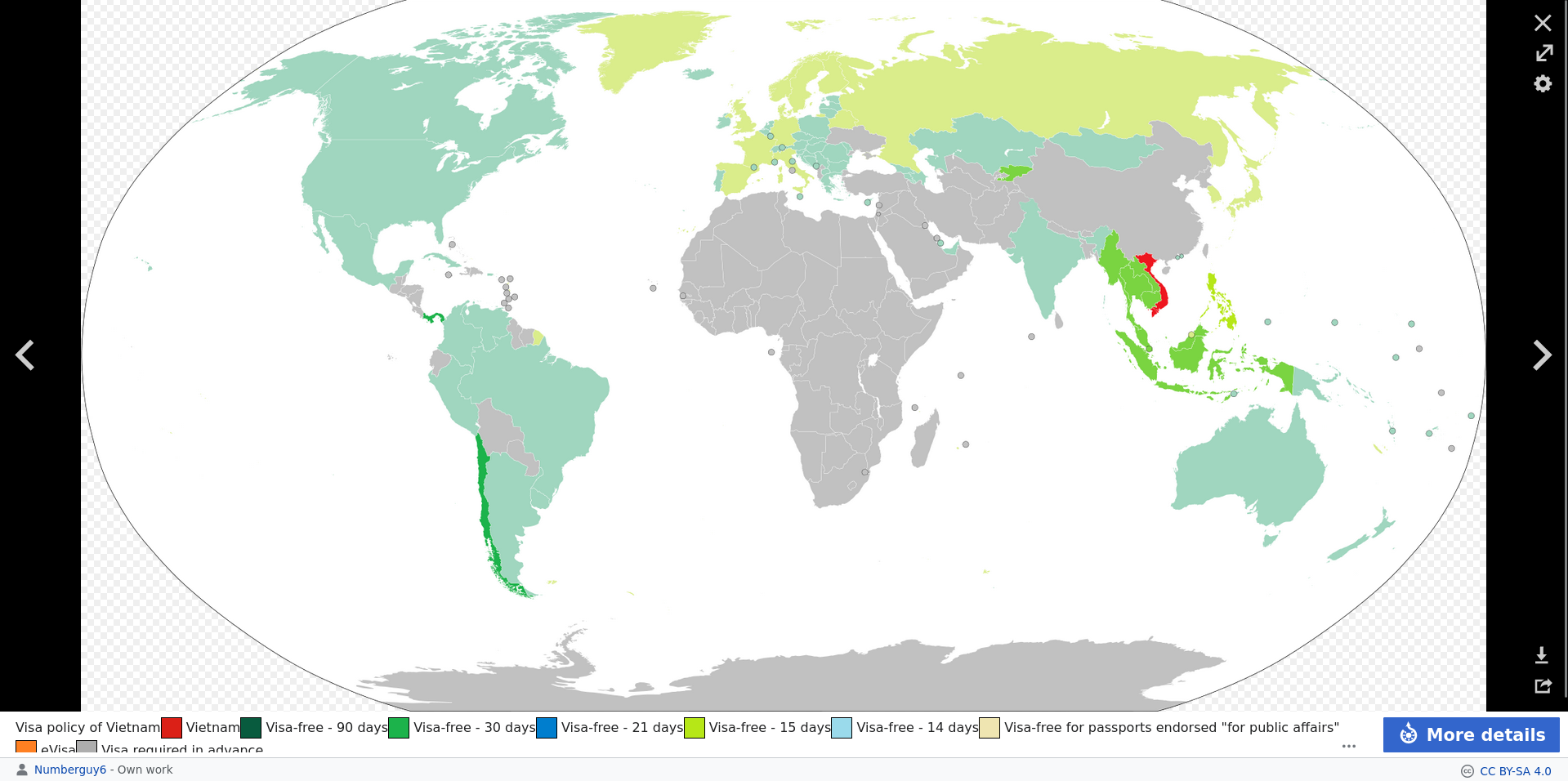Vietnam is a country in Southeast Asia with great food and a wealth of natural and cultural attractions. It can be divided into four zones:
- Northern Vietnam The cradle of the Vietnamese civilization. Harbors some of the most magnificent views of Vietnam, as well as the capital city with and the chance to visit indigenous hill peoples.
- Central Coast The ancient city of Hue was the home of the Vietnamese emperors from 1802—1945, and Hoi An is one of the nicest old seacoast towns in Vietnam.
- Central Highlands Lush forest-covered hills featuring indigenous peoples and the occasional elephant.
- Southern Vietnam The economic engine of Vietnam, built around Ho Chi Minh City but also covering the lush and little-visited Mekong Delta, the rice basket of Vietnam.

Some of the main cities and destinations are:
- Hanoi (Hà Nội) — Vietnam's capital and major tourist destination
- Ho Chi Minh City (Thành Phố Hồ Chí Minh) — Vietnam's largest and most cosmopolitan city, formerly known as Saigon (Sài Gòn) when it was the capital of South Vietnam
- Da Nang (Đà Nẵng) — largest city in central Vietnam
- Dalat (Đà Lạt) — French colonial hill station in the highlands
- Haiphong (Hải Phòng) — the "port city", a major port in north Vietnam
- Hoi An (Hội An) — well-preserved ancient port, near the ruins of My Son
- Hue (Huế) — former home of Vietnam's emperors
- Nha Trang — burgeoning beach resort
- Vinh — the major city in north-central Vietnam with very nice Cua Lo Beach
- Con Dao — islands off the Mekong Delta
- Cu Chi — site of the Cu Chi Tunnels
- Cuc Phuong National Park — home to some of Asia's rarest wildlife and the Muong hill people The DMZ — ruins of old American military bases, spectacular mountain scenery and rugged jungles
- Ha Long Bay — famous for its unearthly scenery
- Ninh Binh — Ha Long Bay-like karst scenery along the river
- Phu Quoc — island just off the coast of Cambodia, known for its beaches, fish sauce and seafood
- Sa Pa — meet native indigenous people in the hills by the Chinese border
- Phong Nha Caves World Heritage cave system in Quang Binh province.
Entry requirements
Visitors from the following countries do not require a visa and can stay for the following number of days:

Visitors from many countries are now eligible for a 30-day electronic visa (e-Visa), which you apply for through an online portal and print out yourself after it's approved. It typically takes 3 working days to process and costs US$25. See the "E-Visa" section below for more details.
In order to boost tourism, the Vietnamese government has made the island of Phu Quoc a visa-free zone. Those flying there through Ho Chi Minh City or arriving by boat will not need to apply for a visa beforehand. This is regardless of your nationality. Visitors are given 15 days to spend on the island. Those wishing to travel elsewhere can apply for a proper Vietnamese visa at the local immigration office. All passports should be valid for at least 45 days when arriving in Phu Quoc.
If you aren't eligible for an e-Visa (because of your nationality), or if it isn't suitable for your purposes (because you need to enter within less than 3 days, or want to enter at a remote border crossing that isn't included in the system), visas can be applied for at most Vietnamese embassies and consulates abroad. This will generally cost at least double the price of the e-Visa (see "Visa fees" below). If your country does not have a Vietnamese embassy or consulate, a popular alternative would be to apply at the Vietnamese embassy in Bangkok.
Visa fees
If you aren't eligible for an e-Visa, or need a traditional visa for some other reason (for example, because you need to enter within less than three days, or because you want to enter at a remote border crossing that's not included in the e-Visa program), the cost of applying depends on your nationality and the embassy or consulate you are applying at. Check with the Vietnamese embassy or consulate in your country of residence, or the country you are in, for details. Embassies are (oddly) reluctant to announce fees on their websites, as the relatively high visa costs are a tourism deterrent, but nevertheless a source of revenue. Email or, even better, call them to get up-to-date information on prices. Or if you're in the same city, walk in and ask in person. As of 2019, one of the reportedly cheapest places to get a visa are the Vietnamese embassy and consulates in Cambodia, starting at US$40 for a one month, single entry visa.
Some Vietnamese embassies offer a "While you wait service" (May 2008 - it's unclear whether this is still the case), where a single entry visa can be gained in 15 minutes. This service costs US$92, but approval is instant. You are required to bring a valid passport, passport photo and payment in US$ (credit cards not accepted). If this service is not offered, you may still be able apply for a visa and get it back later the same day (for example, at the Vietnamese embassy in Phnom Penh, Cambodia). Make sure to inquire about the details, since if you don't complete the application before a certain time of day, you will need to wait until the next day to pick up the visa and your passport. E-Visa
e-Visas, if you are from a country for which they are available, cost US$25 from the official website. Vietnam's e-Visa service provides an online application at the website of the Vietnamese immigration office. This procedure is available for 80 countries, including most European ones. The regular e-Visa is valid for 30 days, for single entry and has a duration of 4 weeks after entering and costs US$25. Don't forget to pay, which is a separate step after confirming your application. It takes about 3 working days to issue, and a delay in payment may or may not delay it further. The automatic email confirmation is not reliable and you have to check for yourself online whether you have received the visa. You should print out a paper copy of your visa once it is approved, and be prepared to show it when entering the country and possibly also when checking in for your flight.
e-Visas are valid at major airports and seaports and most, but NOT ALL land crossings (for example, they are not accepted between Banlung, Cambodia and Pleiku, Vietnam). A full list of valid crossings is available on the e-Visa website, though many of them use obscure local names that can be difficult to find on maps. In theory, entry and exit from the country should be from the same airport, seaport, or land crossing as stipulated on the e-Visa form, but in reality this is usually not enforced on the way out, though you must enter on the date and at the place stipulated on the visa. You are more likely to encounter problems due to typos in vital data such as your name or birth date.
Other types of e-Visa, like multiple entry and extended duration, are available with additional documents and information required.
If you want to enter Vietnam at a crossing that's not included in the e-Visa program, or if you need to enter within less than 3 business days, you can still apply for a traditional, physical visa at a Vietnamese embassy or consulate.
The two primary routes for enter Vietname are train and plane.
By train
There is a nightly sleeper train between Nanning in China and Hanoi, taking 12 hours, including a tedious 2+2 hours at the border - see Hanoi#Get in for details. Through service are also available from Beijing, but travellers will need to change railway coaches at Nanning.
The old metre-gauge Kunming-Hanoi line has closed, and the simplest work-around is to take the high speed train from Kunming to Nanning to join the overnight train to Hanoi. Another option is to travel to Hekou North Station in China, walk across the border from Hekou to Lao Cai, then take a Vietnamese train from Lao Cai to Hanoi. Both sides have several trains a day, so a daytime train from Kunming to Hekou can be matched with an overnight train from Lao Cai to Hanoi.
There are no railway links between Vietnam and Laos or Cambodia.
By plane
Vietnam's main international airports are located at Hanoi (HAN IATA) and Ho Chi Minh City (SGN IATA). Both airports are served by numerous flights from major cities in East Asia and Southeast Asia, with some intercontinental services to Australia, Europe and the United States.
Other international airports are located at Da Nang, Vinh, Nha Trang and Phu Quoc, though flights are limited to those from neighboring Asian countries. As Da Nang is closer to the historical sites of Central Vietnam than the two main airports, it can make a convenient entry point for those who specifically wish to visit those sites.
The national carrier is Vietnam Airlines, which operates flights into Vietnam's two largest cities from various cities in Australia, Asia and Europe. Vietnam Airlines serves all capital cities of Southeast Asian countries except Dili, Bandar Seri Begawan and Naypyidaw. The largest low cost carrier is Vietjet Air which flies to an increasing number of regional destinations including Bangkok, Chiang Mai, Hong Kong, New Delhi, Seoul, Singapore and Yangon.
